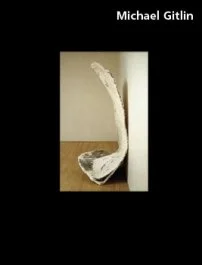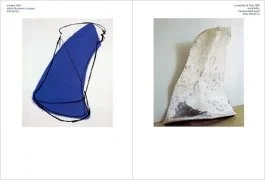Galerie Katrin Rabus 1996
The Object in Crisis
by Barry Schwabsky
At least since 1987, when I first began following Michael Gitlin's work - though the indications provided by that mute witness, photography, suggest this has been the case much longer - it has been characterized above all by its restlessness. Gitlin has never been willing to settle into a formula, even the subtler formula of eclecticism or change for its own sake. His work has been driven by dissatisfaction. If his most recent period, unusually, has been dominated by drawing rather than by sculpture, this suggests first of all that this productive dissatisfaction has attained even greater intensity.
To put it as briefly as possible: Gitlin's "blue" drawings are not what they might have been had they been the drawings of a painter. In that case we could easily have seen in them merely a continuation of that tactical dissociation of line from color with which we are already familiar from the work of Leger, Matisse, or Mondrian (not to mention Warhol).
And of course that remains an element here. But there is something more at stake, which I do not hesitate to call a crisis of the object. Don't misunderstand me. As Gitlin is a sculptor rather than a painter (although he has shown himself capable of assimilating painterly means and pictorial issues within his sculpture), so, a fortiori, he is a sculptor rather than an object-maker. (The object-maker is to the sculptor as the image-maker is to the painter.) The object in crisis - for Gitlin at least, and perhaps only for him, such is the risk of the artist - implicates the subject of sculpture more than its means.
For the sculptor, there is the object and there is the space it inhabits, and these must have a determinate relationship. This relationship is perhaps the true subject of the work. Drawing lends itself to the sculptor's thinking just insofar as it is essentially a question of black and white, that is, of a polarity. This dichotomy between black and white serves as a useful analogy for the fundamental sculptural dichotomy of object and space. In Gitlin's drawings, despite appearances, blue does not occur fundamentally as color, but rather, more abstractly, as the third term, the thing that is neither black nor white - il terzo in-comodo, as the Italians say.
A line, to be sure, can never be more than the abstraction of the object it means to describe, unless it becomes a truly concrete line that describes nothing but itself, as Michael Fried once claimed the lines of Jackson Pollock's poured paintings did - but this is certainly not what the line in Gitlin's drawings means to do. So color is called upon, as a rule, to lend body to this ghostly contour. But not in these drawings. Yes, this blue reminds us of that promise of body, of weight, of mass, of real presence. But only long enough to make us feel the disappointment of its vanishing. This more than usually opaque blue is, somehow, more than usually transparent as well. "A blue of extraordinary enhancements," to borrow a phrase from Wallace Stevens, it is the shadow or stain left by the vanishing of the objects presence. The object, it seems, is nothing more than a coincidence of two spectres, the density of their intersections.
No wonder Gitlin, in the grip of such awareness, has produced few sculptures of late - and each of those quite distinct, a singular venture at resolution. The artist himself cites Add Venture as the inception of this phase of his oeuvre - a work in which he took the base of a classical column in Ashkelon and cast it twice, once in rubber and once in aluminum, in the process of submitting it to formal transmutations. The two materials, one solid yet visually as well as materially light, the other dense and dark yet yielding, each contradicts the qualities of the original stone and its reassuring function as an architectural support in a different way. In and Out of Time, the most recent of Gitlin's sculptures, suggests that elucidation will come - as it has for Gitlin before (for instance with Broken Infinity, Bonner Kunstverein, 1988) through a trial of the containing architectural space.
A kind of parody of the meeting of wall and floor, this work is somehow saved from its own ghostliness - a whiteness receding into transparency, as though what in drawing had served to designate space had invaded the object itself and then begun to abscond - by the single anchor of a wooden slat resting on a floor made of wooden slats: reality adhering to itself, desperately.


